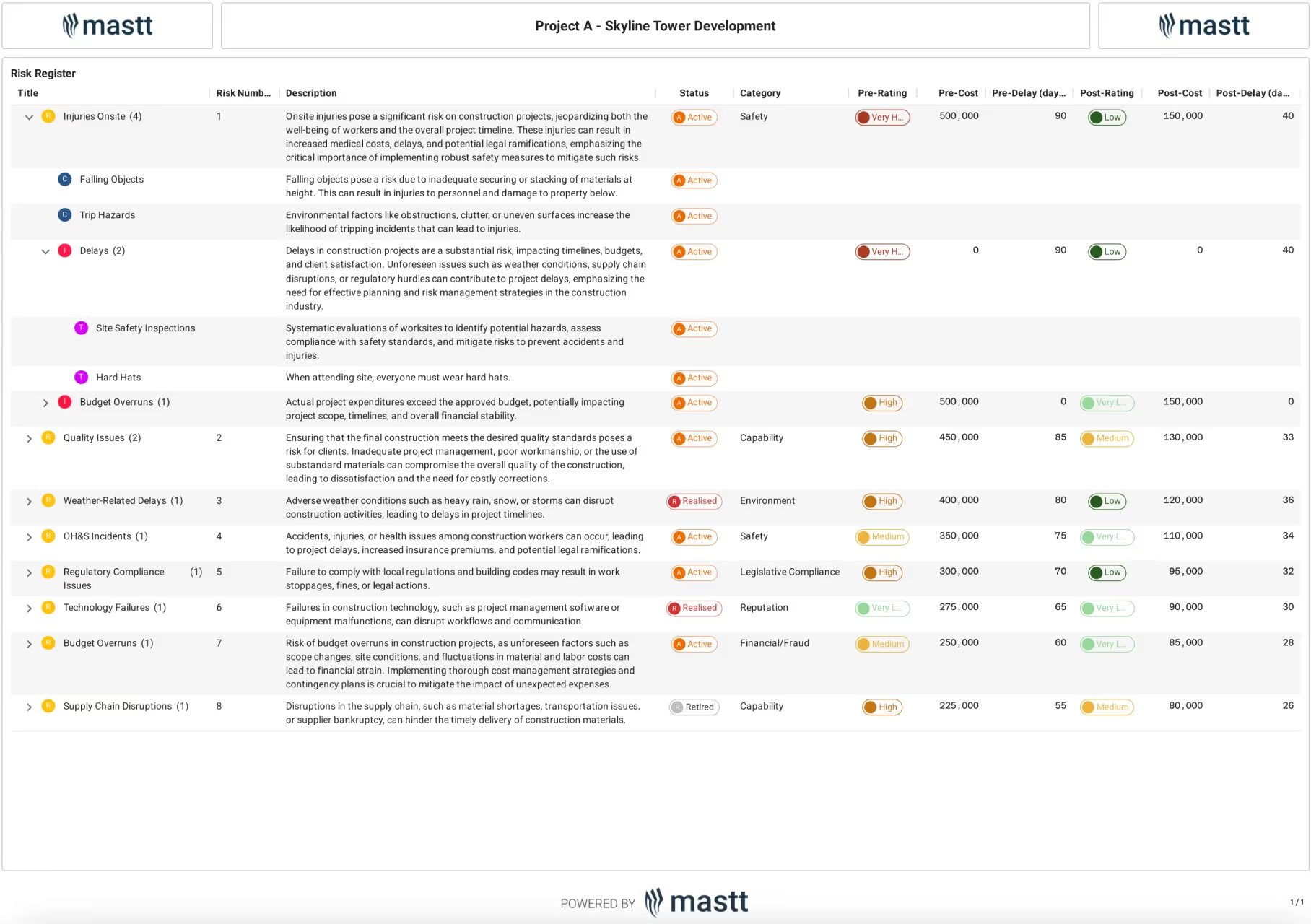Construction challenges in 2025 are reshaping how the industry delivers projects. Rising costs, labor shortages, regulatory delays, productivity pressures, and sustainability demands are driving risk. This article outlines each challenge, why it matters now, and the actions construction professionals can take.
1. Skilled Labor Shortages
Skilled labor shortages remain one of the most urgent construction challenges in 2025. The pool of qualified workers and project managers is shrinking while demand grows. This shortage pushes up costs, slows delivery, and increases risks on site.
The main aspects of this skilled labor shortage problem can be broken down as follows:
- Causes: A shrinking workforce, weak apprenticeship uptake, an aging demographic, and competition from other industries.
- Impacts: Longer schedules, higher wages, reduced quality control, and increased safety concerns.
- Warning signs: Persistent unfilled roles, rising overtime costs, slower project starts, and higher turnover among skilled trades.
- Stakeholders affected: Project owners face cost overruns, contractors and general contractors manage delays, and workers experience fatigue and burnout.
- Common mistakes: Overreliance on short-term fixes, neglecting training pipelines, and pushing longer shifts instead of addressing root causes.
- Solutions / Best practices: Expand apprenticeships, streamline migration programs, invest in worker retention, and adopt prefabrication, AI, robotics, and project management software to reduce labor demand.
- KPIs to track: Craft vacancy rate, turnover levels, overtime hours, training completion, and wage growth in skilled trades.
In the United States, the industry must attract an estimated 439,000 additional workers in 2025. In June 2025, there were 246,000 open construction jobs, and 78 percent of firms reported difficulty filling craft roles.
Labor gaps are expected to intensify as demand for housing and infrastructure grows worldwide. Every construction company that invests early in skills development and labor-saving technology will protect margins and keep construction projects moving.
2. Rising Material Costs and Supply Issues
Volatile material prices are among the most pressing construction industry problems today. Steel, timber, and concrete costs continue to shift unpredictably, leaving budgets exposed. These market condition risks cause disputes, thin margins, and frequent project delays.
Here’s how rising costs are affecting the construction sector:
- Causes: Inflation, tariffs on imports, shipping bottlenecks, global demand surges, and supply chain disruption.
- Impacts: Slimmer margins, delayed projects, disputes over fixed-price contracts, and greater risk of insolvency.
- Warning signs: Rapid increases in supplier quotes, late deliveries, and growing disputes over escalation clauses.
- Stakeholders affected: Owners face rising project costs, contractors deal with schedule risk, and subcontractors struggle with material availability.
- Common mistakes: Relying on single-source suppliers, signing fixed-price contracts without escalation clauses, and failing to forecast material needs.
- Solutions / Best practices: Diversify suppliers, bulk purchase critical items, add escalation clauses, explore sustainable alternatives, and apply advanced forecasting.
- KPIs to track: Price variance vs. budget, on-time deliveries, escalation coverage, lead time variance, and committed cost tracking.
Construction input prices remain elevated in the United States. By June 2025, inputs were 43% above February 2020, based on BLS Producer Price Index data. In July 2025, materials and services for nonresidential construction rose 2.6% year over year, with tariffs pressuring aluminum, steel, and copper items.
Construction cost trends point to continued volatility rather than relief. Construction companies that lock in flexible contracts and explore alternative materials will gain more control and improve project success.
3. Regulatory and Planning Delays
Lengthy approvals and compliance checks are persistent construction industry issues. Even well-financed projects can sit idle for months while permits move through agencies. The result is higher holding costs and fewer completed projects.
The common regulatory delays typically show up in these ways:
- Causes: Understaffed planning departments, complex building codes, environmental reviews, and new compliance rules.
- Impacts: Costly project delays, higher financing charges, reduced housing starts, and halted infrastructure pipelines.
- Warning signs: Prolonged permit cycle times, repeated resubmittals, and slow reviewer turnaround.
- Stakeholders affected: Developers and owners face holding costs, consultants and PMs lose time, and contractors wait on approvals.
- Common mistakes: Submitting incomplete applications, failing to engage regulators early, and not accounting for regulatory risks in project scope.
- Solutions / Best practices: Hold pre-application meetings, adopt digital permitting systems, standardize designs, and use building information modeling for compliance.
- KPIs to track: Permit cycle time, resubmittals, reviewer turnaround days, and digital submission rates.
Federal environmental reviews often extend timelines for major projects. Council on Environmental Quality reports a 2024 median of 2.2 years from notice to final EIS. San Francisco’s median approval times were 133 days for planning and 209 days for building.
Without reform, planning delays will remain one of the most persistent construction industry problems, choking housing supply and infrastructure pipelines. Agencies adopting digital permitting and fast-track reviews cut delays and reduce holding costs.
4. Productivity and Economic Pressures
Low productivity combined with inflation is creating major construction problems. Inefficient workflows and rising borrowing costs put pressure on project budgets. These factors weaken margins and threaten financial stability across the sector.
The main elements of this productivity and economic pressure challenge are as follows:
- Causes: Manual processes, fragmented supply chains, poor collaboration, and low adoption of digital tools.
- Impacts: Missed deadlines, cost overruns, lower profitability, and insolvency risks.
- Warning signs: Declining plan percent complete, frequent rework, late payments, and poor cost performance index results.
- Stakeholders affected: Owners see higher costs, project managers face schedule pressure, and contractors risk financial instability.
- Common mistakes: Relying on outdated processes, neglecting digital adoption, and failing to coordinate subcontractors.
- Solutions / Best practices: Implement lean construction, adopt project management software and BIM, and integrate delivery models for efficiency.
- KPIs to track: Plan percent complete, schedule performance index, cost performance index, rework hours, and productivity per worker.
U.S. contractors are facing productivity declines and economic strain. BLS reports productivity in highway, street, and bridge construction decreased from 2019 to 2023. AGC’s 2025 Outlook shows that two-thirds of postponed or canceled projects, and 16 percent are already affected in 2025.
Economic turbulence will continue to test margins. Construction firms that digitize workflows and collaborate more closely across the supply chain will be better placed to withstand financial pressure.
5. Technology and Sustainability Adoption
Slow adoption of new tools and green practices is now one of the major construction challenges in 2025. Many construction firms hesitate to invest due to upfront costs or training barriers. This delay holds back efficiency gains and slows compliance with climate goals.
The main aspects of this technology and sustainability challenge can be outlined as follows:
- Causes: High upfront costs, lack of training, cultural resistance, and unclear regulations.
- Impacts: Slower project delivery, higher emissions, reduced competitiveness, and compliance risks.
- Warning signs: Limited BIM coverage, reliance on paper-based systems, and lack of digital as-builts.
- Stakeholders affected: Owners miss out on lifecycle savings, contractors face inefficiency, and project managers struggle with fragmented data.
- Common mistakes: Treating technology as optional, underinvesting in training, and piloting too many tools without scaling.
- Solutions / Best practices: Invest in BIM, robotics, drones, AI-powered platforms, and modular construction with clear ROI tracking.
- KPIs to track: BIM usage, digital as-builts coverage, drone progress captures, and technology adoption rates.
State DOTs are adopting digital delivery tools through federal support. In November 2023, FHWA awarded $34 million to 10 state projects. ADCMS grants fund 3D models, digital as-builts, e-ticketing, and connected machinery. Recipients included California, Illinois, Pennsylvania, Utah, and Washington.
As climate and compliance demands tighten, adopting construction technology will shift from optional to essential. Those who adopt the latest technology will lead in both cost and compliance.
6. Safety, Mental Health, and Worker Well-being
Safety and well-being remain serious concerns on construction sites around the world. Accidents, stress, and poor oversight continue to impact workers. These risks add liability, increase costs, and make it harder to retain staff.
The issues with safety, mental health, and worker well-being can be summarized as follows:
- Causes: Dangerous environments, limited enforcement, poor safety culture, and lack of mental health support.
- Impacts: Injuries, lawsuits, costly turnover, and reputational damage.
- Warning signs: Rising near-miss incidents, excessive overtime, and repeated violations.
- Stakeholders affected: Workers face health risks, owners and contractors face liability, and PMs manage higher risk exposure.
- Common mistakes: Cutting corners on safety, underreporting incidents, and neglecting worker well-being programs.
- Solutions / Best practices: Deploy wearable safety tech, enforce stricter oversight, strengthen mental health support, and run frequent safety audits.
- KPIs to track: TRIR (Total Recordable Incident Rate), DART (Days Away, Restricted, or Transferred) rate, near misses, fall incidents, corrective actions closed, and toolbox talk completion.
Falls are the leading cause of death in U.S. construction. In 2023, the BLS recorded 1,075 construction fatalities, including 421 fatal falls to a lower level. OSHA launched a National Emphasis Program on falls to reduce these deaths.
Worker well-being will shape the industry’s future. Firms that take proactive steps to prevent construction accidents and protect mental health will build stronger teams and reduce costly turnover.
7. Sustainability and Circular Economy
Sustainability and circular practices have become unavoidable construction challenges. The industry generates vast amounts of waste and contributes heavily to emissions. Meeting new regulations requires rethinking design, materials, and delivery models.
Sustainability and circular economy challenges are unfolding in several ways:
- Causes: Dependence on resource-heavy construction materials, wasteful practices, and stricter environmental regulations.
- Impacts: Rising compliance costs, reputational risks, and clients demanding greener construction projects.
- Warning signs: Growing waste diversion gaps, lack of EPD (Environmental Product Declaration) coverage, and client pushback on sustainability.
- Stakeholders affected: Owners face regulatory pressure, contractors manage compliance costs, and consultants must meet new reporting standards.
- Common mistakes: Treating sustainability as optional, delaying investment in circular practices, or overlooking lifecycle impacts.
- Solutions / Best practices: Use recycled materials, adopt modular reuse, implement net-zero design, and track lifecycle impacts.
- KPIs to track: Waste diversion rate, Environmental Product Declaration (EPD) coverage, low-carbon share of materials, and sustainability compliance scores.
EPA reports U.S. construction generated 600 million tons of C&D debris in 2018. About 455 million tons were sent to next use through recycling and reclamation. California’s AB 2953 requires local agencies, starting in 2024, to allow recycled materials in civil engineering projects.
Sustainability will define market competitiveness. Construction companies that embrace circular building and low-carbon materials will lead in securing future projects.
8. Corruption and Ethical Misconduct
Corruption and ethical misconduct persist in parts of the construction sector. Bribery, fraud, and conflicts of interest undermine trust in projects. These corruption practices inflate costs and weaken confidence in the industry.
The key aspects of this corruption challenge can be broken down as follows:
- Causes: Complex procurement systems, lack of transparency, weak oversight, and high financial stakes in large infrastructure.
- Impacts: Inflated material costs, project delays, reputational damage, reduced investor confidence, and poor-quality construction work.
- Warning signs: Unexplained cost overruns, irregular subcontractor selection, opaque bidding processes, and misaligned project scope changes.
- Stakeholders affected: Owners and governments face financial losses, contractors risk reputational harm, project managers deal with delays, and workers suffer from poor-quality or unsafe projects.
- Common mistakes: Ignoring whistleblower reports, failing to audit procurement, and underestimating the reputational risks of unethical conduct.
- Solutions / Best practices: Implement transparent bidding processes, enforce anti-corruption policies, adopt digital procurement platforms, and use AI-powered construction project management software to track contracts and payments in real time.
- KPIs to track: Number of procurement audits, compliance scores, reported incidents of misconduct, and percentage of competitive bids vs. negotiated contracts.
Globally, corruption in the construction sector is estimated to add 10 to 30 percent to project costs. In many cases, only part of the allocated budget translates into real construction, with the rest lost to kickbacks or waste. This directly results in poorly built infrastructure, delays, and reduced confidence in both contractors and regulators.
In February 2024, prosecutors charged 70 current and former NYCHA employees in a kickback scheme. The indictment alleges cash payments from contractors for no-bid work orders at public housing sites. In the first trial, a former superintendent was later convicted of bribery and extortion.
Another good example of this construction challenge is the flood control projects controversy in the Philippines in August 2025, where investigations uncovered ghost projects, inflated contracts, and substandard works. Reports found that less than half of the allocated funds went into real construction, leaving communities exposed despite billions being spent.
Stronger oversight and digital procurement will be vital to reducing corruption risks in construction projects. Firms and the government that prioritize transparency and ethics will gain investor and public trust and achieve long-term project success.
90-Day Action Plan to Tackle 2025 Construction Challenges
This 90-day action plan is designed to turn major challenges into measurable improvements. Each 10-day step gives construction leaders clear priorities, helping stabilize projects, reduce risk, and build momentum.
Use the phased steps below to move from baseline to improvements:
By the end of 90 days, construction projects should show steadier schedules, clearer cost visibility, and fewer surprises. Weekly scorecards keep teams aligned, and leadership should act quickly on red flags.
Turning Challenges in the Construction Industry Into Opportunities
The construction challenges are also chances to build resilience. Labor shortages highlight the need to strengthen training pipelines and explore automation. Rising material costs force companies to rethink procurement and consider sustainable alternatives.
Each issue signals where change can deliver real gains. Firms that treat challenges as opportunities will not only reduce risk but also set the pace for the future of construction.















